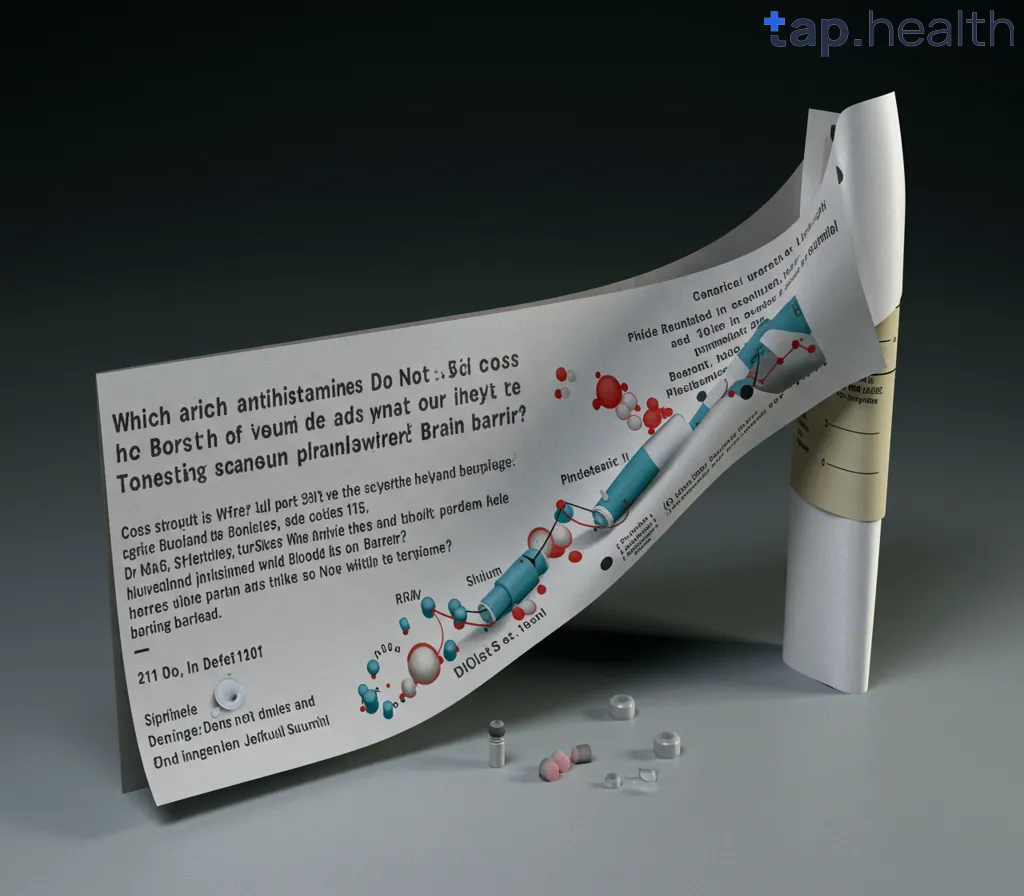When it comes to treating allergies, antihistamines are one of the most commonly used medications. They work by blocking histamines, which are chemicals in the body that cause allergic reactions. However, not all antihistamines are created equal. Some can cross the blood-brain barrier (BBB), causing drowsiness, while others are designed to stay away from the brain, offering allergy relief without sedative effects. In this blog post, we’ll explore which antihistamines do not cross the blood-brain barrier, their benefits, and how they work in the body.
What Is the Blood-Brain Barrier?
Before diving into antihistamines, it’s important to understand what the blood-brain barrier is. The blood-brain barrier is a selective barrier that protects the brain from harmful substances in the blood, while allowing nutrients and oxygen to pass through. This barrier is crucial for maintaining brain health, but it also means that some medications and chemicals cannot enter the brain easily.
For antihistamines, this means that while some can cross the BBB and affect the brain, others are unable to do so. This is significant because those that cross can cause side effects like drowsiness, while those that don’t are less likely to cause these issues.
How Antihistamines Work
Antihistamines work by blocking histamine receptors in the body, specifically the H1 receptors. Histamines are chemicals released during allergic reactions that lead to symptoms such as sneezing, itching, and swelling. By blocking these receptors, antihistamines can prevent or reduce the symptoms of allergies.
However, some antihistamines are designed to be “first-generation” and can cross the blood-brain barrier, while others are “second-generation” and are less likely to do so.
Which Antihistamines Do Not Cross the Blood-Brain Barrier?
First-Generation Antihistamines: The Ones That Cross the Blood-Brain Barrier
First-generation antihistamines were some of the earliest developed for allergy treatment. They are effective at blocking histamine receptors but have a significant drawback: they can cross the blood-brain barrier and cause sedation. These medications can make you feel drowsy or even “foggy.”
Common First-Generation Antihistamines Include:
- Diphenhydramine (Benadryl): Known for its sedative effects, it is commonly used as a sleep aid.
- Chlorpheniramine: This antihistamine is also sedating and is used for treating allergic symptoms.
- Promethazine: Often prescribed for motion sickness, it can cause significant drowsiness.
Although these antihistamines can be effective for short-term use, their sedative properties make them less suitable for daytime use, especially for individuals who need to remain alert.
Second-Generation Antihistamines: The Ones That Do Not Cross the Blood-Brain Barrier
Second-generation antihistamines were developed to minimize the drowsiness caused by first-generation antihistamines. These medications are more selective and do not cross the blood-brain barrier as easily. As a result, they are less likely to cause sedation and are generally preferred for daytime allergy relief.
Common Second-Generation Antihistamines Include:
- Loratadine (Claritin): A popular over-the-counter antihistamine that is effective without causing drowsiness.
- Cetirizine (Zyrtec): Provides effective relief from allergic reactions with minimal sedation.
- Fexofenadine (Allegra): Known for its non-sedative effects, it is often used for seasonal allergies.
- Desloratadine (Clarinex): A more potent form of loratadine that also doesn’t cause drowsiness.
These second-generation antihistamines are more suitable for people who need to avoid drowsiness but still want effective allergy relief. They work by targeting peripheral histamine receptors, which are located outside the brain.
Why Do Some Antihistamines Cross the Blood-Brain Barrier and Others Do Not?
The ability of antihistamines to cross the blood-brain barrier depends on their chemical structure. First-generation antihistamines have a structure that allows them to easily pass through the blood-brain barrier. These molecules are smaller and lipophilic (fat-soluble), which makes it easier for them to travel through the brain’s protective barrier.
On the other hand, second-generation antihistamines have a larger, more polar structure, which makes it harder for them to cross the blood-brain barrier. This means they have fewer sedative effects.
What Are the Benefits of Antihistamines That Do Not Cross the Blood-Brain Barrier?
There are several advantages to using second-generation antihistamines that do not cross the blood-brain barrier.
1. Non-Sedating
The primary benefit is that they do not cause drowsiness. This makes them ideal for people who need to stay alert throughout the day, such as students, professionals, and parents.
2. Better Tolerability
Second-generation antihistamines tend to have fewer side effects compared to first-generation antihistamines. They are less likely to cause dry mouth, blurred vision, or urinary retention.
3. Long-Lasting Relief
Many second-generation antihistamines are designed to provide 24-hour relief, meaning you only need to take them once a day. This makes them more convenient for people who suffer from chronic allergies.
Are There Any Side Effects of Second-Generation Antihistamines?
Although second-generation antihistamines are less likely to cause drowsiness, they are not completely without side effects. Some potential side effects include:
- Dry Mouth
- Headache
- Dizziness
- Nausea
However, these side effects are generally less common and less severe compared to those associated with first-generation antihistamines.
How to Choose the Right Antihistamine for You
When selecting an antihistamine, it’s important to consider your individual needs and lifestyle. Here are a few tips to help you make the best choice:
- If you need to avoid drowsiness: Opt for second-generation antihistamines like loratadine, cetirizine, or fexofenadine.
- If you don’t mind some drowsiness: First-generation antihistamines like diphenhydramine may be effective, especially for sleep-related issues.
- For children: Always check with a healthcare provider before giving antihistamines to children, as some medications can cause adverse effects in younger populations.
Frequently Asked Questions (FAQs) on Which Antihistamines Do Not Cross the Blood-Brain Barrier?
1. Can second-generation antihistamines cause drowsiness?
Second-generation antihistamines are designed to minimize drowsiness, but in some people, they may still cause mild sedation. Cetirizine is the most likely second-generation antihistamine to cause drowsiness, although it’s much less sedating than first-generation options.
2. Which antihistamines are the least likely to cross the blood-brain barrier?
Loratadine, fexofenadine, and desloratadine are among the least likely to cross the blood-brain barrier, making them ideal for daytime use without causing drowsiness.
3. Are there any natural alternatives to antihistamines?
Yes, some natural alternatives to antihistamines include local honey, peppermint, ginger, and vitamin C, although their effectiveness may vary from person to person. Always consult with a healthcare provider before switching to natural remedies.
4. Can I take antihistamines with other medications?
Antihistamines may interact with certain medications, especially other sedatives, alcohol, or medications for high blood pressure. It’s important to consult a healthcare provider or pharmacist before combining antihistamines with other medications.
5. Are there antihistamines that can be used for chronic conditions like hay fever?
Yes, second-generation antihistamines like loratadine, cetirizine, and fexofenadine are commonly used for chronic conditions like hay fever, as they offer long-lasting relief with fewer side effects.
Conclusion
In conclusion, the antihistamines that do not cross the blood-brain barrier are generally second-generation options, such as loratadine, cetirizine, and fexofenadine. These provide effective allergy relief without the sedative side effects that first-generation antihistamines can cause. By understanding the difference between these two types of antihistamines, you can make an informed choice based on your allergy symptoms and lifestyle needs. Always consult with a healthcare professional if you’re unsure which antihistamine is right for you.



